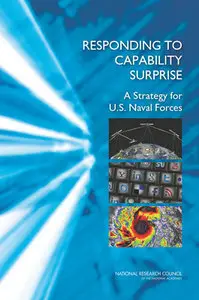Responding to Capability Surprise: A Strategy for U.S. Naval Forces
Committee on Capability Surprise on U.S. Naval Forces; Naval Studies Board; Division
NAS Press | 2013 | ISBN: 0309278376 9780309278379 | 203 pages | PDF | 9 MB
Committee on Capability Surprise on U.S. Naval Forces; Naval Studies Board; Division
NAS Press | 2013 | ISBN: 0309278376 9780309278379 | 203 pages | PDF | 9 MB
This volume examines the issues surrounding capability surprise, both operational and technical, facing the U.S. Navy, Marine Corps, and Coast Guard. The recommendations will help to ensure more responsive, more resilient, and more adaptive behavior across the organization from the most senior leadership to the individual sailors, Marines, and Coast Guardsmen.
This report selects a few surprises from across a continuum of surprises, from disruptive technologies, to intelligence-inferred capability developments, to operational deployments, and assesses what the Naval Forces are doing (and could do) about them while being mindful of future budgetary declines.
The report examines which processes are in place or could be in place in the Navy, the Marine Corps, and the Coast Guard to address such surprises.
Contents
Summary
1 Framing the Problem
Background
Defining “Surprise”
Initial Observations
Capability Surprise Framework
Crosscutting Activities
Options for Coordinating Surprise Mitigation
Leadership
Finding and Recommendation
2 Scanning and Awareness
Background
Examples from the Commercial and Academic Sectors
The Scanning and Awareness Approach
Finding and Recommendation
3 Assessing Surprise
Methods to Assess and Analyze Surprise
System-of-Systems Modeling and Simulation for Experimentation and Risk Reduction
Technology-Focused Vulnerability Study Groups
Improving Red Teams Through Nontraditional Perspective
Modeling and Red Teaming Opportunities in the Committee Defined Scenarios
Finding and Recommendation
4 Prioriti zation, Option Development, and Decision
Formulation
Introduction
Conceptualizing Raw Options to Mitigate High-Risk Surprises
Candidate Option Evaluation
Concept Refinement and Proof of Principle (Assume Three Viable Options)
Prioritization: Three Options—Which Is the Most Attractive?
Develop Transition Decision Package
Finding and Recommendation
5 Resource and Transition Planning
The PPBE System and Surprise
Mitigating Risk of Surprise Within the PPBE Process
A Policy of Resilience to Mitigate Risk and Enhance Response
Operational Scenarios with Anticipated Surprises and Policy Implications
Organizational and Budget Implications
Integration and Interoperability
Presence Versus Preparation
Resourcing Implications
Finding and Recommendation
6 Implementation and FIELDING
Introduction
Repurposing
Architectures
Rapid Acquisition
Test and Initial Training
Finding and Recommendations
7 Force Response (Preparation and Readiness)
Force Readiness—An Overview
TTPs and CONOPS Development for Preparation and Response
Measuring Force Readiness Today
Preparation and Response Through Exercises, Training, and Experimentation
Shortfalls in Current Preparation and Response
Strategies for Implementation
Maximizing the Impact of Our Surprise Capabilities
Final Thoughts
8 Putti ng It All Together
R oles and Activities
Organizational Allocation of Study Recommendations
E xamples of the Proposed Framework for the Three Scenarios
The Way Ahead
APPENDIXES
A Scenarios
B E xemplars
C Biographies of Committee Members and Staff
D Acronyms and Abbreviations
E G lossary
F Study Briefings and Organizational Interfaces
with TOC BookMarkLinks



